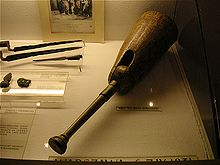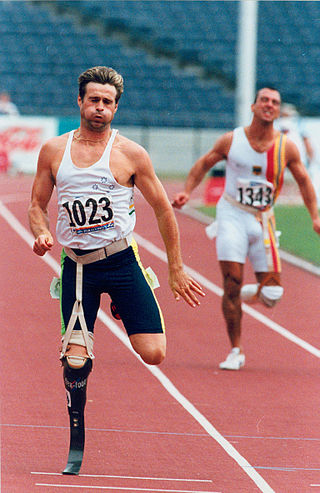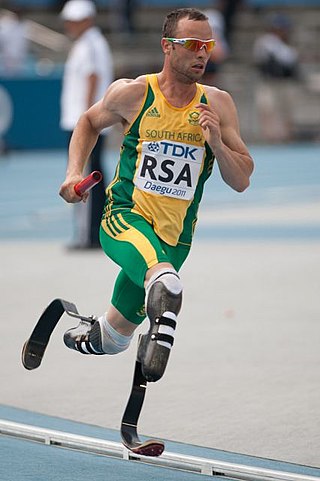
A peg leg is a prosthesis, or artificial limb, fitted to the remaining stump of a human leg, especially a wooden one fitted at the knee. [1] Its use dates to antiquity. [2]

A peg leg is a prosthesis, or artificial limb, fitted to the remaining stump of a human leg, especially a wooden one fitted at the knee. [1] Its use dates to antiquity. [2]
By the late 19th century, prosthetics vendors would offer peg legs as cheaper alternatives to more intricate, lifelike artificial legs. [3] Even as vendors touted advantages of more complicated prostheses over simple peg legs, [3] according to a contemporary surgeon, many patients found a peg leg more comfortable for walking. [4] According to medical reports, some amputees were able to adjust to the use of a peg leg so well that they could walk 10, or even 30, miles in one day. [5]
Nowadays, wooden peg legs have been replaced by more modern materials, though some sports prostheses do have the same form. [6]

Amputation is the removal of a limb by trauma, medical illness, or surgery. As a surgical measure, it is used to control pain or a disease process in the affected limb, such as malignancy or gangrene. In some cases, it is carried out on individuals as a preventive surgery for such problems. A special case is that of congenital amputation, a congenital disorder, where fetal limbs have been cut off by constrictive bands. In some countries, judicial amputation is currently used to punish people who commit crimes. Amputation has also been used as a tactic in war and acts of terrorism; it may also occur as a war injury. In some cultures and religions, minor amputations or mutilations are considered a ritual accomplishment. When done by a person, the person executing the amputation is an amputator. The oldest evidence of this practice comes from a skeleton found buried in Liang Tebo cave, East Kalimantan, Indonesian Borneo dating back to at least 31,000 years ago, where it was done when the amputee was a young child.

In medicine, a prosthesis, or a prosthetic implant, is an artificial device that replaces a missing body part, which may be lost through physical trauma, disease, or a condition present at birth. Prostheses are intended to restore the normal functions of the missing body part. Amputee rehabilitation is primarily coordinated by a physiatrist as part of an inter-disciplinary team consisting of physiatrists, prosthetists, nurses, physical therapists, and occupational therapists. Prostheses can be created by hand or with computer-aided design (CAD), a software interface that helps creators design and analyze the creation with computer-generated 2-D and 3-D graphics as well as analysis and optimization tools.
Body integrity dysphoria (BID), also referred to as body integrity identity disorder (BIID), amputee identity disorder or xenomelia, and formerly called apotemnophilia, is a rare mental disorder characterized by a desire to have a sensory or physical disability or feeling discomfort with being able-bodied, beginning in early adolescence and resulting in harmful consequences. BID appears to be related to somatoparaphrenia. People with this condition may refer to themselves as transabled.

Ambroise Paré was a French barber surgeon who served in that role for kings Henry II, Francis II, Charles IX and Henry III. He is considered one of the fathers of surgery and modern forensic pathology and a pioneer in surgical techniques and battlefield medicine, especially in the treatment of wounds. He was also an anatomist, invented several surgical instruments, and was a member of the Parisian barber surgeon guild.
Neuroprosthetics is a discipline related to neuroscience and biomedical engineering concerned with developing neural prostheses. They are sometimes contrasted with a brain–computer interface, which connects the brain to a computer rather than a device meant to replace missing biological functionality.
Targeted reinnervation enables amputees to control motorized prosthetic devices and to regain sensory feedback. The method was developed by Dr. Todd Kuiken at Northwestern University and Rehabilitation Institute of Chicago and Dr. Gregory Dumanian at Northwestern University Division of Plastic Surgery.
Therdchai Jivacate is a Thai orthopedic surgeon and inventor known for his humanitarian activities in providing free prosthetic limbs to impoverished amputees, and for his development of techniques allowing low-cost, high-quality prostheses to be made from local materials. The activities of the Prostheses Foundation, which he founded in 1992 under royal sponsorship from the Princess Mother Srinagarindra, have expanded beyond the borders of Thailand to Malaysia, Laos, and Burma. Jivacate has established Thailand's first and only educational institution of occupational therapy at Chiang Mai University. He has also created an educational programme for children suffering from chronic diseases at Maharaj Hospital in Nakhon Ratchasima. In 2008, he was given the Ramon Magsaysay Award for Public Service.
Hanger, Inc. is a leading national provider of products and services that assist in enhancing or restoring the physical capabilities of patients with disabilities or injuries that is headquartered in Austin, Texas. The company provides orthotic and prosthetic (O&P) services, distributes O&P devices and components, manages O&P networks, and provides therapeutic solutions to patients and businesses in acute, post-acute, and clinical settings. Hanger, Inc. operates through two segments: Patient Care and Products & Services.

Hugh Herr is an American rock climber, engineer, and biophysicist. When he was young, both of his legs were amputated below the knee during a blizzard in a rock climbing trip. After months of surgeries and rehabilitation, Herr began climbing again, using specialized prostheses he designed for himself, becoming the first person with a major amputation to perform in a sport on par with elite-level, able-bodied persons. He holds the patents to the Rheo Knee, an active ankle-foot orthosis, which is the world's first powered ankle-foot prosthesis.
T43 is a disability sport classification for disability athletics, applying to athletes with "Double below knee amputation or similar disability." It includes ISOD classified athletes from the A4 and A9 classes.

T44 is a disability sport classification for disability athletics, applying to "Single below knee amputation or an athlete who can walk with moderately reduced function in one or both legs." It includes ISOD A4 and A9 classes.

The mechanics of the running blades used by South African former Paralympic runner Oscar Pistorius depend on special carbon-fiber-reinforced polymer prosthetics. Pistorius has double below-the-knee amputations and competed in both non-disabled and T44 amputee athletics events. Pistorius's eligibility to run in international non-disabled events is sanctioned by the International Association of Athletics Federations (IAAF).
Amputee sports classification is a disability specific sport classification used for disability sports to facilitate fair competition among people with different types of amputations. This classification was set up by International Sports Organization for the Disabled (ISOD), and is currently managed by IWAS who ISOD merged with in 2005. Several sports have sport specific governing bodies managing classification for amputee sportspeople.
A2 is an amputee sport classification used by the International Sports Organization for the Disabled (ISOD).for people with acquired or congenital amputations. A2 sportspeople have one leg amputated above the knee. Their amputations impact their sport performance, including having balance issues, increased energy costs, higher rates of oxygen consumption, and issues with their gait.
A3 is an amputee sport classification used by the International Sports Organization for the Disabled (ISOD) for people with acquired or congenital amputations. A3 classified sportspeople have both legs amputated below knee. Their amputations impact their sport performance, including having balance issues, increased energy costs, higher rates of oxygen consumption, and issues with their gait. Sports people in this class are eligible to participate in include athletics, swimming, sitting volleyball, archery, weightlifting, badminton, lawn bowls, sitzball and wheelchair basketball.
A4 is an amputee sport classification used by the International Sports Organization for the Disabled (ISOD).for people with acquired or congenital amputations. People in this class have one leg amputated below the knee. Their amputations impact their sport performance, including having balance issues, increased energy costs, higher rates of oxygen consumption, and issues with their gait. Sports people in this class are eligible to participate in include athletics, swimming, sitting volleyball, archery, weightlifting, wheelchair basketball, amputee basketball, amputee football, lawn bowls, and sitzball.
A1 is an amputee sport classification used by the International Sports Organization for the Disabled (ISOD) for people with acquired or congenital amputations. This class is for sportspeople who have both legs amputated above the knee. Their amputations impact their sport performance, including having balance issues, increased energy costs, higher rates of oxygen consumption, and issues with their gait. Sports people in this class are eligible to participate in include athletics, swimming, sitting volleyball, archery, weightlifting, badminton, lawn bowls, sitzball and wheelchair basketball.
Robert S. Gailey Jr., PT, PhD, FAPTA, is an American physical therapist; professor at the University of Miami Miller School of Medicine Department of Physical Therapy; and the Director of the Neil Spielholz Functional Outcomes Research & Evaluation Center. His research efforts include amputee rehabilitation, prosthetic gait, and functional assessment. He developed the Amputee Mobility Predictor (AMP), an outcome measure designed to evaluate the ambulatory potential of lower-limb amputees with and without the use of a prosthesis. In 2002, he was appointed as a Special Advisor to the United States Department of Defense for amputee rehabilitation. In the aftermath of the 2010 Haiti earthquake, he served as the rehabilitation coordinator for Project Medishare.

Gait deviations are nominally referred to as any variation of standard human gait, typically manifesting as a coping mechanism in response to an anatomical impairment. Lower-limb amputees are unable to maintain the characteristic walking patterns of an able-bodied individual due to the removal of some portion of the impaired leg. Without the anatomical structure and neuromechanical control of the removed leg segment, amputees must use alternative compensatory strategies to walk efficiently. Prosthetic limbs provide support to the user and more advanced models attempt to mimic the function of the missing anatomy, including biomechanically controlled ankle and knee joints. However, amputees still display quantifiable differences in many measures of ambulation when compared to able-bodied individuals. Several common observations are whole-body movements, slower and wider steps, shorter strides, and increased sway.
Robert D. Gregg is an American bioengineer, roboticist, inventor and academic. He is an associate professor at the University of Michigan.